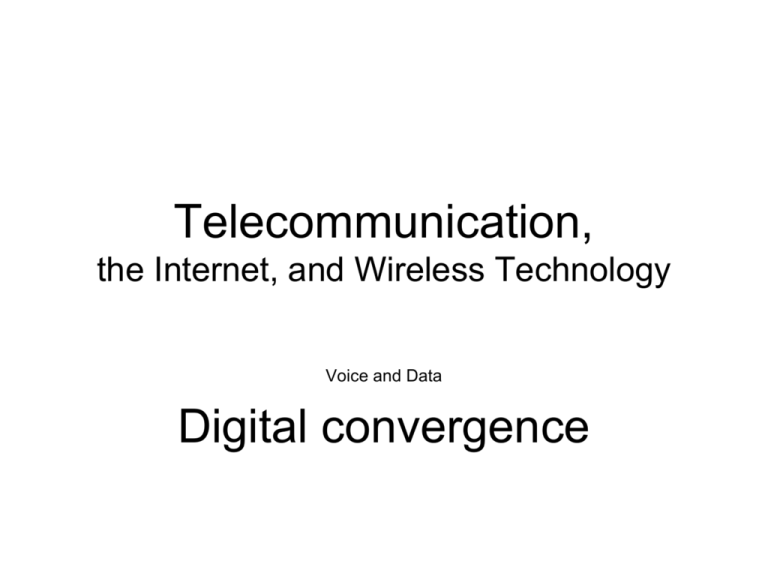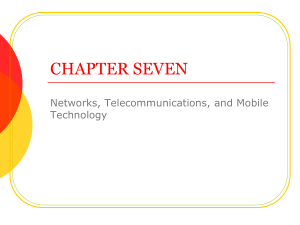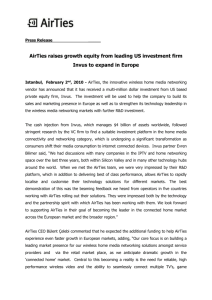Telecommunication, the Internet, and wireless Technology
advertisement

Telecommunication, the Internet, and Wireless Technology Voice and Data Digital convergence • Continental Tire – Hanover, Germany – Global auto & truck parts manufacturer • 164,000 employees • 46 countries – One of the tires factory in France • 1,000 different kinds of tires • 1.5 million square feet • Raw material – Sheet of rubber on wheeled carts – Manually tracking if carts are not in expected location – Sometimes lost track of tire components altogether – Missing material • Bottlenecks and production delay – Real-time location system • Wi-Fi & RFID (Radio frequency identification) tag • Inventory tracking system software – Implementation • RFID tags on 1,100 carts • Carts transmit signal to Cisco Wi-Fi network • Mobile-view software pick up the signal – Show the carriers on a map – Tuggers • Small trucks for hauling carriers • DLOG – Mobile vehicle-mounted computer • Access MobileView – Pull up a map – See an icon where the carrier is – Material inventory tracking systems • Barcodes attached – Components – Carriers • Associated with RFID info • Productivity increased – When components are needed • Tugger driver use DLOG to – Identify the location of carrier • Scan barcode to – Update material status • Fewer material is thrown away – Expired – Not used when needed 7.1 Telecommunications and Networking in today’s business world 7.2 Communication networks 7.3 The global Internet 7.4 The wireless revolution 7.1 Telecommunication & Networking in today’s business world • CANT stay in business without networks – Communication with • Employees • Customers • Supply partners » EMS (Electronic Manufacturing Service) Foxcomm, Flextronic – 982, 98% within 2 days – 1002, 100% within 2 days – Used to be • Telephone networks: voice communication • Computer networks: data traffic – Today • Single digital network – Internet based standards and equipment • Voice, video, and data communications – More powerful: faster – More portal: smaller and mobile – Less expensive • What is a Computer Network – Two or more computers connected • • • • • Client computers Dedicate server computer Network interface Connection medium Network operating system • Network interface card, NIC – Hardware • Network operating systems – Route and manage communication – Coordinate network resources • Novell, Netware • Microsoft • Linux Network: consist of two or more connected computers • Networks communication equipments – Hub • Connect network equipment – Switch • Filter and forward data to a specified location – Router • Connect two or more networks • Direct packets to its destination (routing tables) • Same protocol – Gateway • Different protocols • Networks in large companies – Corporate-wide networking infrastructure • Large numbers of LAN • A number of powerful servers – Corporate website – Corporate intranet – Extranet • Back-end systems – ERP – Order entries • Key digital networking technologies – Client/Server computing • Distributed computing model – Processing power » Small, inexpensive client computers – Server » Set the rule of communication » Provide each client with an address • Replaced centralized mainframe computers – Processing on a central large computer • Packet switch 封包交換 vs. analog switch 類比交換 – Packet • Method of slicing digital messages into parcels – Route • Different communication path as available – Reassemble • Once arrive destination • TCP/IP and connectivity – Network • Diverse hardware and software components – Protocol • Common set of rules • Governing transmission of information – Proprietary protocol • Incompatible – TCP/IP • Single, common, worldwide standard • US Department of Defense – TCP, transmission control protocol » Handle the movement of data – IP, Internet Protocol » Delivery of packets » Disassembling and reassembling of packets 7.1 Telecommunications and Networking in today’s business world 7.2 Communication networks 7.3 The Internet 7.4 The wireless revolution 7.2 Communication Networks • Signals: digital vs. analog – Analog • Continuous waveform • voice – Digital • Digital, binary waveform • String of two discrete states: zero bits & one bits • Computer – Modem: device to translate digital into analog … • Types of networks – Classify by geographic scope • Local Area network, LAN – Connect PCs and other digital devices within 500 meters » Small office » In one building • Campus area network • Metropolitan area network • Wide area network • LAN – Peer-to-peer architecture • Treat all processors equally • Do not need server to – Exchange data – Share peripheral 7.1 Telecommunications and Networking in today’s business world 7.2 Communication networks 7.3 The Global Internet 7.4 The wireless revolution 7.3 The Global Internet • Indispensable personal and business tool • What is the Internet – The world’s most extensive, public communication network – Client/server computing – Internetworking – Began in the early 1970s • Department of Defense • Internet addressing and architecture – TCP/IP protocol suite – Every computer on the Internet • Unique IP address – 32 bit – 4 strings of numbers » 1 – 255 » Separate by DOT – 140.117.71.1 IPv4 – Message send on the Internet • Decompose into packets – Using the TCP • Packets contain its destination address • Send from client to network •… – DNS, Domain name server • Domain name – English-like names that corresponds to the IP address » www.microsoft.com • Convert IP to domain name – Vice versa • Hierarchical structure – Root domain » Top level domain second level domain • Internet architecture and governance – Backbone • Transcontinental high speed network • Own and operate by – Long distance company » Network service providers – National government Metropolitan area exchange Network access point – No one “owns” the Internet • No formal management • Worldwide Internet policies – Established by professional organizations and government bodies » The Internet corporation for assigned names and number (ICANN) assign ip address » The world wide web consortium (W3C) set standards for HTML – Internet can be censored as traditional broadcast media – The Internet is not “free” • Student, employee do not pay for access – Organization and business pay its own local Internet connection service • Inexpensive • Fast communication medium • The future Internet: IPv6 and Internet2 – IPv4 • 32 bits addressing – 4.5 billion addresses – IPv6 • 128 bits addressing scheme – Shortcomings of Internet • • • • • Poor security No service level guarantees No differential service No differential pricing Bandwidth limitation • Internet 2 • Next generation Internet • Internet Service – Internet based on client/server • Individuals use client software on their computers – Mail, web browse, … • Data store on server – Mail server, website, … • Client platform – PC – Information appliances » Cell phone, PDA • Internet services – – – – – – – – E-mail Chatting and instant messaging Newsgroups Telnet File Transfer Protocol (FTP) World Wide Web VoIP Virtual private network (VPN) Client/server computing on the Internet • Virtual private network, VPN – Secure, private, dedicate network over the public Internet • Encrypted – PPTP » Point-to-point tunneling protocol • Guaranteed bandwidth • Inexpensive – Compare to private network A VIRTUAL PRIVATE NETWORK USING THE INTERNET • World wide web – The most popular Internet service – The universally accepted standards • Storing • Retrieving • Formatting • Displaying Information – Web pages • Formatted using hypertext – Embedded links » Connect documents to one another » Link to other objects graphic video – Hypertext • Hypertext Markup Language (HTML) – Ex: <b> Bold Face </b> – Formats documents – Incorporate dynamic links – HTTP (hypertext transfer protocol) • Communication standard used to transfer hypertext documents – Universal resource locator (URL) • http://bm.nsysu.edu.tw/tutorial/mis/index.html – 網址 » Domain name » Directory path » Document name » Document type – Web server • Software – Locating and managing stored web pages » Locates the web pages requested by a user » Deliver the web pages to the user’s computer • Dedicate computers • Apache HTTP server – 70% • Microsoft Internet Info Service (IIS) – 21% • Website – A collection of web pages linked to a home page – Searching for info on the Web • Surface web – Google visited about 8 billion pages in 2005 • Deep web – Estimated 800 billion additional pages » The Wall Street Journal Online » Protected corporate websites – Search engines • Help finding specific web page nearly instantly – Killer application – Hundreds of different search engines » index – Search engine • Start out in early 1990s • Simple software – Roamed the Web – Visiting pages – Gather info about the page » Crawlers, spiders, wanderers – Search methods – Indexing • Simple keyword indexes – Count the number of times a word appear on the pages – Results may be » very long » not truly relevant • Yahoo! 1994 – Never a real search engine – Edited selection of websites • Google 1998 – Index web pages – Rank search results » Calculate what other sites link to that page PageRank system, (patented) » Keywords & combinations of words – Search engine marketing Internet advertising • Two types of results listings – Sponsor links » Advertisers paid to be listed » Precisely match consumer interests – Un-sponsored “organic” listing – Search engine optimization (SEO) • Optimize the webpages – To achieve a higher ranking with major search engine • Ensure keywords used in webpage to match keywords searched • Link your website to as many other websites – Social search • Fewer, more relevant, and trustworthy search results based on a person’s networks of social contact • Google +1 – User place a +1 next to website they found helpful – When search » +1 sites will list – Intelligent agent shopping Bots • Intelligent agent software • Searching the Internet for shopping information • Web 2.0 – Second generation interactive Internet-based service • Enable user to contribute information – – – – Online photo album Blog Wikipedia 維基百科 Social networking – Popular Web 2.0 innovations • Blogs – Weblog – Informal yet structured web sites » Individual can publish stories, opinions, and link to other sites – Personal publishing tool – Popular Web 2.0 innovations • RSS » Rich site summary » Really simple syndication – Pull specific content from web sites – Feed automatically to users’ computers – Install aggregator or news reader software – Web browser’s RSS capability Business uses RSS to distribute updated corp. info – Popular Web 2.0 innovations • Wiki – User can add, delete, or modify content – wikipedia.org » Online open-source encyclopedia Business use wiki instead of email to – Create meeting agendas – Post training videos • Web 3.0 – Semantic Web • Finding the “meaningful” info • Design computers to analyze and manipulate contents – Paris Hilton – Hilton in Paris • Machine facilitated understanding of information 7.1 Telecommunications and Networking in today’s business world 7.2 Communication networks 7.3 The Internet 7.4 The wireless revolution 7.4 The wireless revolution • Cellular systems Mobile platform for voice & data – Cellular network standards & generations Several competing & incompatible standards • GSM – Global system for mobile communication – The rest of world outside of USA » International roaming • CDMA – Code division multiple access – USA – Cellular generations • Voice • Text message – Short message service • 3G – Third generation networks – 394 kbps ~ 2 Mbps » Video, graphic, … • 4G – 100 Mbps – 1 Gbps • Pre-4G – Long Term Evolution (LTE) – Mobile WiMax • Wireless computer networks and Internet access Bluetooth, WiFi, WiMax – Bluetooth • Personal area network (802.15) – – – – – – Eight devices 10 meters radium Low power Radio based 722 kbps 2.4 GHz band – WiFi • Local area network • 802.11x, x=a, b, g, n – 802.11a » 10 – 30 meters – 802.11b » 30 – 50 meters • Operate in two different modes – Infrastructure Mode » Access point: 無線基地台、寬頻分享器 – Ad hoc, peer-to-peer – Wi-Fi and wireless Internet access • Hotspot – Access points in public place to provide wireless Internet » Free, starbucks » Fee-based hotels, airports • Challenges – Can not roam freely – Weak security features – Susceptibility to interference » Many system operate in the same spectrum – WiMax • • • • Metropolitan Area network 802.16 Range up to 31 miles 75 Mbps – Microwave • RFID & wireless sensor networks – RFID, radio frequency identification Tracking the movement of goods • Transponder, tiny tag – Microchips » Data about items and its location – Transmit radio signals over a short distance » Antenna Fleming's right hand rule • RFID reader An EPC RFID tag used by Wal-Mart Wikipedia.com • RFID reader – Antenna and radio transmitter » 1 inch to 100 feet – Decoding capability • RFID tag comes within the range of the reader – The tag is activated and begin to send data • RFID – Low frequency system » Short reading ranges, (inches and a few feet) » Lower system cost » Security system, asset tracking, animal ID – High frequency system » Can extend beyond 90 feet » Automated toll collection – RFID challenges • Cost of tags – 19 to 5 cents a piece • Massive amount of data generated – Special middleware » Filter » Aggregate » Prevent RFID data from overloading business network Wireless sensor network







